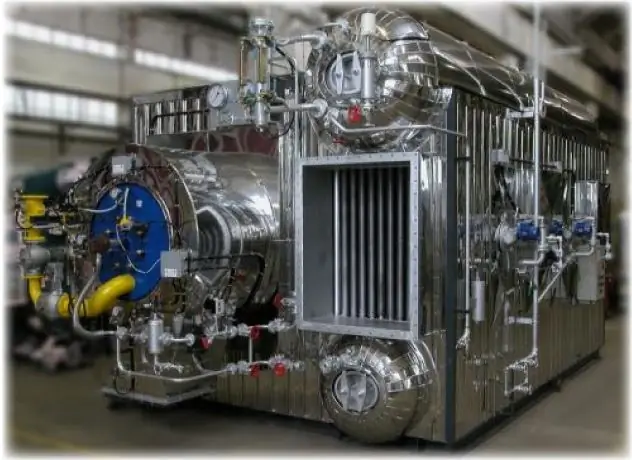- Author Nora Macey [email protected].
- Public 2023-12-16 10:17.
- Last modified 2025-01-23 08:48.
Steam boilers are irreplaceable in a number of technological processes. Their main purpose is to generate saturated and superheated steam, which can be produced in two different ways.

Steam boilers are most widely used as one of the elements of the technological cycle for the production of electricity at thermal power plants. Steam from these boilers enters the blades of the steam turbine, driving it and the generator. Also, saturated steam is in demand in a number of processes for the processing of metal and chemical raw materials, fabrics and plastics.
In utilities of the heating network, steam boilers are used for indirect heating of water in heating systems and for utilizing heat from the combustion products of gas boiler houses. There are two main types of boilers, which differ in the principle of the steam generator device.
Drum steam generators
Drum boilers are the safest, although they are characterized by great complexity of the device. Typically, such boilers are installed together with vortex and cyclone furnaces, in the exhaust ducts of which an economizer is located - a closed pipe system laid in the walls or cavity of the exhaust duct through which combustion products with a high temperature pass. Water is preheated in the economizer, after which it enters through the riser pipes into a drum - a large-volume container with boiling water.
As it moves through the pipes, the water heats up even more, so very active boiling is observed in the drum. The steam generated as a result of evaporation enters the superheater, where its temperature rises, and then to the turbine or to another technological chain. The water that cools down and settles at the bottom of the drum passes through the circulation cycle and is again fed to the riser pipes.
Direct-flow steam boilers
In direct-flow boilers, there is no drum, therefore, the parameters of the steam at the outlet are controlled exclusively by temperature. The efficiency of such boilers is much lower than drum boilers, but the steam generation rate is increased. The internal boiler system is a sequential piping system consisting of three main parts. First, water enters the economizer for primary heating. Then it is pumped under pressure into the evaporator tubes, where it boils and actively evaporates as it moves. After that, the hot steam flow enters the superheater coil, where the temperature and pressure increase.
The principle of the pipeline
Both types of boilers can have both water and gas pipes. The difference is that in the first case, water and steam pass through the pipes, while the heating medium is located around them. In the second case, gases heated during combustion are transported through pipes at a low speed, and they themselves are laid inside a container with water or steam.






